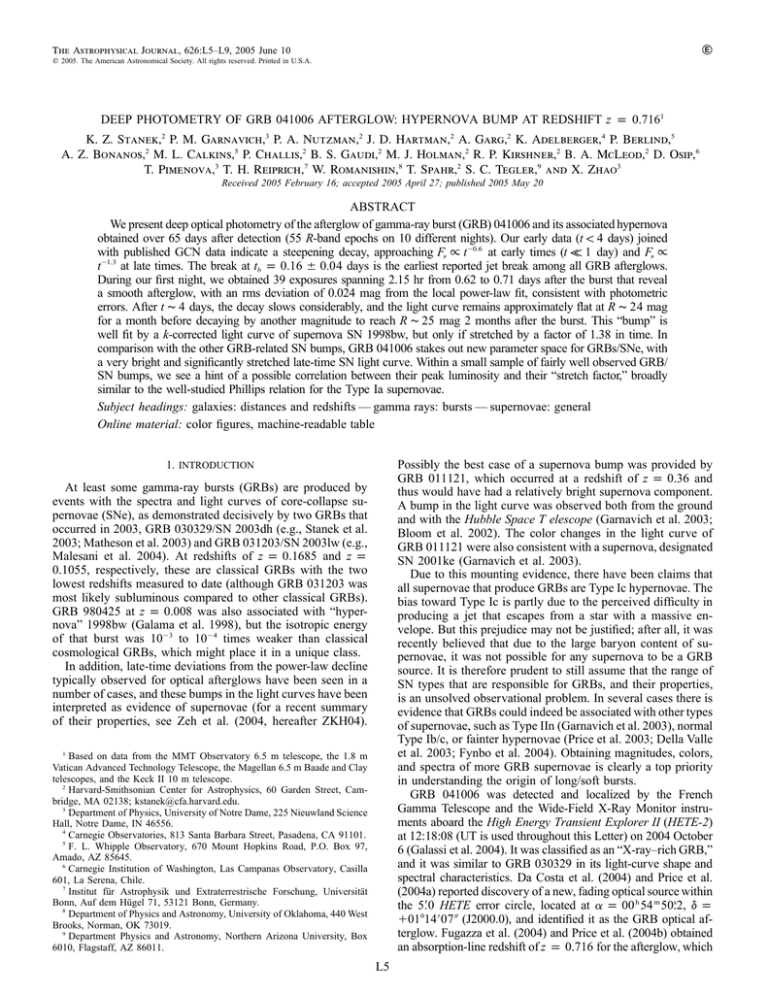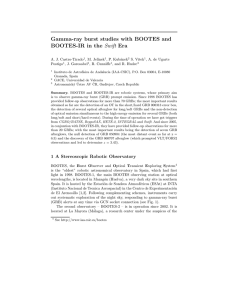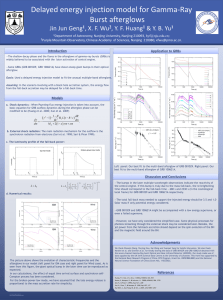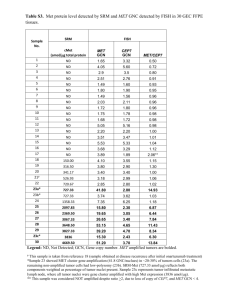
The Astrophysical Journal, 626:L5–L9, 2005 June 10
䉷 2005. The American Astronomical Society. All rights reserved. Printed in U.S.A.
DEEP PHOTOMETRY OF GRB 041006 AFTERGLOW: HYPERNOVA BUMP AT REDSHIFT z p 0.7161
K. Z. Stanek,2 P. M. Garnavich,3 P. A. Nutzman,2 J. D. Hartman,2 A. Garg,2 K. Adelberger,4 P. Berlind,5
A. Z. Bonanos,2 M. L. Calkins,5 P. Challis,2 B. S. Gaudi,2 M. J. Holman,2 R. P. Kirshner,2 B. A. McLeod,2 D. Osip,6
T. Pimenova,3 T. H. Reiprich,7 W. Romanishin,8 T. Spahr,2 S. C. Tegler,9 and X. Zhao3
Received 2005 February 16; accepted 2005 April 27; published 2005 May 20
ABSTRACT
We present deep optical photometry of the afterglow of gamma-ray burst (GRB) 041006 and its associated hypernova
obtained over 65 days after detection (55 R-band epochs on 10 different nights). Our early data (t ! 4 days) joined
with published GCN data indicate a steepening decay, approaching Fn ∝ t⫺0.6 at early times (t K 1 day) and Fn ∝
t⫺1.3 at late times. The break at tb p 0.16 Ⳳ 0.04 days is the earliest reported jet break among all GRB afterglows.
During our first night, we obtained 39 exposures spanning 2.15 hr from 0.62 to 0.71 days after the burst that reveal
a smooth afterglow, with an rms deviation of 0.024 mag from the local power-law fit, consistent with photometric
errors. After t ∼ 4 days, the decay slows considerably, and the light curve remains approximately flat at R ∼ 24 mag
for a month before decaying by another magnitude to reach R ∼ 25 mag 2 months after the burst. This “bump” is
well fit by a k-corrected light curve of supernova SN 1998bw, but only if stretched by a factor of 1.38 in time. In
comparison with the other GRB-related SN bumps, GRB 041006 stakes out new parameter space for GRBs/SNe, with
a very bright and significantly stretched late-time SN light curve. Within a small sample of fairly well observed GRB/
SN bumps, we see a hint of a possible correlation between their peak luminosity and their “stretch factor,” broadly
similar to the well-studied Phillips relation for the Type Ia supernovae.
Subject headings: galaxies: distances and redshifts — gamma rays: bursts — supernovae: general
Online material: color figures, machine-readable table
Possibly the best case of a supernova bump was provided by
GRB 011121, which occurred at a redshift of z p 0.36 and
thus would have had a relatively bright supernova component.
A bump in the light curve was observed both from the ground
and with the Hubble Space T elescope (Garnavich et al. 2003;
Bloom et al. 2002). The color changes in the light curve of
GRB 011121 were also consistent with a supernova, designated
SN 2001ke (Garnavich et al. 2003).
Due to this mounting evidence, there have been claims that
all supernovae that produce GRBs are Type Ic hypernovae. The
bias toward Type Ic is partly due to the perceived difficulty in
producing a jet that escapes from a star with a massive envelope. But this prejudice may not be justified; after all, it was
recently believed that due to the large baryon content of supernovae, it was not possible for any supernova to be a GRB
source. It is therefore prudent to still assume that the range of
SN types that are responsible for GRBs, and their properties,
is an unsolved observational problem. In several cases there is
evidence that GRBs could indeed be associated with other types
of supernovae, such as Type IIn (Garnavich et al. 2003), normal
Type Ib/c, or fainter hypernovae (Price et al. 2003; Della Valle
et al. 2003; Fynbo et al. 2004). Obtaining magnitudes, colors,
and spectra of more GRB supernovae is clearly a top priority
in understanding the origin of long/soft bursts.
GRB 041006 was detected and localized by the French
Gamma Telescope and the Wide-Field X-Ray Monitor instruments aboard the High Energy Transient Explorer II (HETE-2)
at 12:18:08 (UT is used throughout this Letter) on 2004 October
6 (Galassi et al. 2004). It was classified as an “X-ray–rich GRB,”
and it was similar to GRB 030329 in its light-curve shape and
spectral characteristics. Da Costa et al. (2004) and Price et al.
(2004a) reported discovery of a new, fading optical source within
s
the 5⬘. 0 HETE error circle, located at a p 00 h 54 m 50.2
, dp
⫹01⬚14 07 (J2000.0), and identified it as the GRB optical afterglow. Fugazza et al. (2004) and Price et al. (2004b) obtained
an absorption-line redshift of z p 0.716 for the afterglow, which
1. INTRODUCTION
At least some gamma-ray bursts (GRBs) are produced by
events with the spectra and light curves of core-collapse supernovae (SNe), as demonstrated decisively by two GRBs that
occurred in 2003, GRB 030329/SN 2003dh (e.g., Stanek et al.
2003; Matheson et al. 2003) and GRB 031203/SN 2003lw (e.g.,
Malesani et al. 2004). At redshifts of z p 0.1685 and z p
0.1055, respectively, these are classical GRBs with the two
lowest redshifts measured to date (although GRB 031203 was
most likely subluminous compared to other classical GRBs).
GRB 980425 at z p 0.008 was also associated with “hypernova” 1998bw (Galama et al. 1998), but the isotropic energy
of that burst was 10⫺3 to 10⫺4 times weaker than classical
cosmological GRBs, which might place it in a unique class.
In addition, late-time deviations from the power-law decline
typically observed for optical afterglows have been seen in a
number of cases, and these bumps in the light curves have been
interpreted as evidence of supernovae (for a recent summary
of their properties, see Zeh et al. (2004, hereafter ZKH04).
1
Based on data from the MMT Observatory 6.5 m telescope, the 1.8 m
Vatican Advanced Technology Telescope, the Magellan 6.5 m Baade and Clay
telescopes, and the Keck II 10 m telescope.
2
Harvard-Smithsonian Center for Astrophysics, 60 Garden Street, Cambridge, MA 02138; kstanek@cfa.harvard.edu.
3
Department of Physics, University of Notre Dame, 225 Nieuwland Science
Hall, Notre Dame, IN 46556.
4
Carnegie Observatories, 813 Santa Barbara Street, Pasadena, CA 91101.
5
F. L. Whipple Observatory, 670 Mount Hopkins Road, P.O. Box 97,
Amado, AZ 85645.
6
Carnegie Institution of Washington, Las Campanas Observatory, Casilla
601, La Serena, Chile.
7
Institut für Astrophysik und Extraterrestrische Forschung, Universität
Bonn, Auf dem Hügel 71, 53121 Bonn, Germany.
8
Department of Physics and Astronomy, University of Oklahoma, 440 West
Brooks, Norman, OK 73019.
9
Department Physics and Astronomy, Northern Arizona University, Box
6010, Flagstaff, AZ 86011.
L5
L6
STANEK ET AL.
Vol. 626
TABLE 1
Journal of Photometric Observations
DT a
0.6225
0.6311
0.6397
0.6418
0.6437
......
......
......
......
......
RC
jR
texp
(s)
Observatoryb
20.931
20.918
20.973
20.925
20.954
0.023
0.017
0.021
0.021
0.020
120
180
120
120
120
MMT
MMT
MMT
MMT
MMT
Note.—Table 1 is published in its entirety in the electronic edition of the Astrophysical Journal. A portion is
shown here for guidance regarding its form and content.
a
Days after 2004 October 6.5126 UT.
b
MMT: MMT telescope/MegaCam; VATT: Vatican
Advanced Technology Telescope; Clay: Magellan Clay
tel./MagIC; Keck II: Keck II tel./ESI; Baade: Magellan
Baade tel./IMACS.
is fairly low for a GRB. Motivated by the continued need to
study the GRB/SN connection as discussed above, we undertook
photometric monitoring of the optical afterglow of GRB 041006.
In this Letter, we present photometry of the afterglow of GRB
041006 obtained throughout the 2 months immediately following
the burst, which resulted in a clear detection of a light-curve
bump, most likely due to the underlying hypernova. We discuss
the properties of that hypernova compared to the sample of other
well-studied GRB-related SNe.
2. THE PHOTOMETRIC DATA
The photometric data we obtained are listed in Table 1.10 The
majority of our data were obtained with the MegaCam CCD
mosaic (McLeod et al. 2000) mounted on the MMT 6.5 m telescope. Additional data were obtained using the 1.8 m Vatican
Advanced Technology Telescope, the Magellan 6.5 m Baade and
Clay telescopes, and the Keck II 10 m telescope.11
All the data were reduced using DAOPHOT II (Stetson 1987,
1992). For the MMT data, we have used 10–50 stars to establish
the zero-point offset between frames. We found that a nearby
star, 9⬙ west and 4⬙ north of the afterglow, is constant over
many days to within 0.02 mag, with R p 21.90 using the calibration of Garnavich et al. (2004b) and Henden (2004). For
other data, we use that star as the photometric calibrator. For
the MegaCam data, in which a Sloan r filter was used, we
found that it translates well into standard R C filter magnitudes
without a need for a color term.
3. TEMPORAL BEHAVIOR IN THE PHOTOMETRY
3.1. Early Photometry: Days 1–4
Figure 1 presents the R-band light curve for GRB 041006.
We have added some data published via the GCN (see the
caption of Fig. 1 for the references) to fill in the gaps in our
data. All of the GCN data were brought to the common zero
point, and if no photometric error was reported, we adopted a
conservative value of 0.2 mag. We have fit the GRB 041006
10
The analysis presented here supersedes our GCN circulars by Garnavich
et al. (2004b) and Garg et al. (2004).
11
All photometry presented in this Letter is available through anonymous
ftp on cfa-ftp.harvard.edu, in the directory pub/kstanek/GRB041006. Images
are available by request.
Fig. 1.—R-band light curve for GRB 041006. Early data (days 1–4) are fit
to a broken power law (dashed curve). The fit yields a very early break time,
tb p 0.14 days, which might be the earliest jet break reported to date. The
filled circles are our data, while open circles are data from GCN (Kinugasa
& Torii 2004; Kahharov et al. 2004; Fugazza et al. 2004; D’Avanzo et al.
2004; Monfardini et al. 2004; Misra & Pandey 2004; Covino et al. 2004;
Balman et al. 2004; Bikmaev et al. 2004). [See the electronic edition of the
Journal for a color version of this figure.]
data with the broken power-law model of Beuermann et al.
(1999; see also Stanek et al. 2001):
FR (t) p
2FR, 0
,
[(t/tb ) a1 s ⫹ (t/tb ) a 2 s]1/s
(1)
where tb is the time of the break, FR, 0 is the R-band flux at tb,
and s is a parameter that determines the sharpness of the break
(a larger s gives a sharper break). This formula smoothly connects the early time t⫺a1 decay (t K tb) with the later time
t⫺a 2 decay (t k tb). Equation (1) has been used to describe the
afterglow decay of, e.g., GRBs 990510 (with s p 1) and
010222 (Stanek et al. 1999, 2001). The fit results in the following values for the parameters: a1 p 0.59 Ⳳ 0.13, a 2 p
1.32 Ⳳ 0.02, and tb p 0.16 Ⳳ 0.04 days (we have fixed the
value of s p 2.5). Given the nonuniform data used (i.e., GCN
plus our data), the quoted values for the errors of these parameters should be treated with caution.
The resulting fit is shown as the dashed curve in Figure 1.
The curve is a good fit to the early afterglow, with a x2 per
degree of freedom (dof) of 1.1. The fit yields a very early break
time, tb p 0.16 Ⳳ 0.04 days, which is the earliest reported afterglow break (see the compilation of break times, tjet, in Table 1 of Friedman & Bloom 2005; see also Ghirlanda et al.
2004). Given the implications for the jet opening angle and the
energetics of the burst, it would be valuable to further constrain
the break time with robust calibration of other early data.
Short-timescale variability has been seen in the light curves
of several afterglows, including GRB 011211 (e.g., Holland et
al. 2002) and GRB 021004 (e.g., Bersier et al. 2003). Motivated
to look for such short-timescale variability in GRB 041006,
No. 1, 2005
HYPERNOVA BUMP IN GRB 041006
L7
the first night on the MMT we obtained 39 high signal-to-noise
ratio exposures of the afterglow, spanning 2.15 hr from 0.62
to 0.71 days after the burst. No short-timescale variability is
present in our data, and the rms deviation of 0.024 mag from
the local power-law fit is consistent with random errors of the
photometry. The afterglow of GRB 041006 joins other wellobserved afterglows, such as GRB 990510 (Stanek et al. 1999)
and GRB 020813 (Laursen & Stanek 2003), in the category
of very smooth afterglows.
3.2. Later Photometry: Days 5–65
Over the subsequent 2 months, we obtained R-band observations of the optical transient (OT) on a number of epochs.
We combine our data with three additional R-band photometric
measurements published via GCN (Covino et al. 2004; Balman
et al. 2004; Bikmaev et al. 2004). These observations are presented in Figure 2.
As is apparent in Figure 2, the decay abruptly slows ∼5 days
after the burst. For slightly more than a month, the brightness
then remains roughly flat at R ∼ 24 mag. Over the next
30 days, the OT decays by another magnitude, falling to R ∼
25 mag in our final observations.
This clear detection of a light-curve “bump” strongly suggests the late-time dominance of the OT by an underlying
supernova component. The supernova component peaks at
roughly ∼24 mag about 35 days after the burst, which is several
magnitudes brighter than the extrapolated optical afterglow of
the GRB at the time of this peak.
To estimate the properties of the hypernova bump in GRB
041006, we correct for the effects of Galactic extinction using
the reddening map of Schlegel et al. (1998). At the Galactic
coordinates of GRB 041006, l p 124⬚. 74, b p ⫺61⬚. 66, the
foreground reddening is E(B ⫺ V ) p 0.023, yielding an expected extinction of AR p 0.06. We find that the OT light curve
can be well modeled by a stretched SN 1998bw–like bump, kcorrected to redshift z p 0.716, combined with the continued
power-law decay of the GRB optical afterglow. It is clear from
the data that the amount of stretching of the SN 1998bw light
curve needed is significant, and it is basically determined by
the rapid decline by about a magnitude from 36.9 to 56.5 days
after the burst. The composition is shown as the solid line in
Figure 2. Indeed, we find a good fit using as a template the
light curve of SN 1998bw, uniformly stretched in time by a
factor of 1.38 Ⳳ 0.06 (in addition to the 1 ⫹ z cosmological
time dilation), and with significantly brighter peak absolute
magnitude (0.3 mag brighter). We did not fit for the brightness
of the host, as its influence on the derived R-band magnitudes
would vary for our data set obtained with different telescopes,
instruments, and varying seeing conditions. To account for that,
we adopt an asymmetric error bar for the peak brightness of
the supernova of ⫺0.1, ⫹0.2 mag.
Thus, the hypernova component in the late-time OT of GRB
041006 is long-lasting, in contrast to, e.g., GRB 01121/SN
2001ke (Garnavich et al. 2003) and GRB 030329/SN 2003dh
(Lipkin et al. 2004; Deng et al. 2005), in which the bumps
decay faster than SN 1998bw (see next section for more discussion). As in the case of GRB 030329/SN 2003dh (Matheson
et al. 2003), we find no need to introduce a time delay (either
positive or negative) between the afterglow and the supernova
component to fit the light-curve data. In fact, adding a time
delay parameter degrades the x 2/dof value slightly. The bestfit time delay is ⫺0.9 Ⳳ 2.7 days; i.e., the GRB and the SN
were most likely simultaneous.
Fig. 2.—Late R-band light curve for GRB 041006. The open circles are
data from GCN, while the filled circles show our data. The early-time broken
power-law decay of the optical afterglow is shown as the dashed line. A kcorrected SN 1998bw light curve extended by a factor of 1.38 is shown as
the dotted curve. The combined power law and stretched SN 1998bw light
curve is given by the solid curve. [See the electronic edition of the Journal
for a color version of this figure.]
4. SUMMARY AND DISCUSSION
We have obtained deep photometry of the optical transient
associated with GRB 041006 for the first 2 months following
the burst. We find that the early-time R-band light curve is well
fit by a broken power law, with a prebreak index of a1 p
0.59 and a steeper postbreak index of a 2 p 1.32. Our fit yields
a break time of tb p 0.16 days after the burst, the earliest jet
break observed so far. Early observations also show a very
smooth afterglow, with short-timescale deviations from the
power-law decay on the same order (0.025 mag) as random
errors in photometry.
Continuing observations of the optical transient over the
2 months following the burst show an abrupt change from the
t⫺1.3 decay of the afterglow, consistent with the domination of
the photometry by a SN component. The SN light curve peaks
at a similar brightness to SN 1998bw but takes more time
following the burst to evolve, by a factor of ∼1.38.
To put the light-curve features of GRB 041006 into the
context of previous GRB/SN observations, we have adopted
Figure 3 from ZKH04, which presents the deduced time stretch
factors relative to SN 1998bw versus their deduced luminosity
ratios of GRBs/SNe relative to SN 1998bw. They consider nine
GRBs, observed before the end of 2002, for which there exists
some evidence of a SN bump. They have suggested a subdivision of these GRBs into a group of five with weak evidence
of a bump and a group of four with statistically significant
evidence of a bump (GRBs 990712, 991208, 011121, and
020405; see § 3 of ZKH04). In our Figure 3, we present only
this latter group, with the additions of GRB 030329/SN 2003dh,
which occurred after their cutoff date, and GRB 041006. For
GRB 030329/SN 2003dh, we adopt the values for the parameters from a recent paper by Zeh et al. (2005, hereafter ZKH05).
It should be stressed that given the bumpy and long-lasting
L8
STANEK ET AL.
Vol. 626
z p 0.717. Also, very interestingly, all GRBs with optical afterglows and measured redshifts less than that of GRB 041006
show evidence of late-time SN components (ZKH04). As is
apparent in Figure 3, GRB 041006 stakes out new parameter
space for GRBs/SNe, with a very bright and significantly
stretched late-time SN light curve.
The distribution of light-curve stretch factors and peak
brightnesses for hypernovae shown in Figure 3 is reminiscent
of the relation found by Phillips (1993) for Type Ia SNe (technique introduced by Perlmutter et al. 1997 for their sample of
Type Ia). We overplot the Type Ia relation extended to fastdeclining events by Garnavich et al. (2004a) and extrapolated
to large stretch factors. While the uncertainties for the hypernovae make a conclusive statement difficult, we note that both
the hypernovae and Type Ia events are likely powered by 56Ni
decay and have similar peak luminosities implying comparable
56
Ni masses. But with the present data available for them, hypernovae are still a long way from being useful distance indicators. More events like GRB 041006 will be possible to
study soon, as the Swift satellite (Gehrels et al. 2004) is already
providing accurate localizations for a good number of GRBs.
Fig. 3.—Time stretch factor relative to SN 1998bw vs. luminosity relative to
SN 1998bw for six GRBs/SNe (see also Fig. 3 from ZKH04). Dashed lines at a
stretch factor of 1 and a luminosity ratio of 1 represent SN 1998bw values. The
four filled circles represent data for four GRBs/SNe given in ZKH04. GRB 030329/
SN 2003dh (triangle) and the SN component for GRB 041006 (star) are also shown
(see text for more discussion). Plotted with the continuous line is the analogous
relation for Type Ia supernovae, adopted from Garnavich et al. (2004a).
afterglow of GRB 030329, the exact parameters for the underlying SN 2003dh are still subject to debate (Matheson et al.
2003; Lipkin et al. 2004; Deng et al. 2005). We decided not
to include another recent GRB/SN case, GRB 031203/SN
2003lw, as it was heavily obscured by foreground Galactic dust
and resided in a rather luminous host galaxy. For that supernova, ZKH05 give values for the stretch of 1.14 Ⳳ 0.16 and
luminosity ratio of 1.65 Ⳳ 0.41. We note that, among this sample of six, GRB 041006 possesses the highest redshift, with
We would like to thank the staffs of the MMT, VATT, Las
Campanas, and Keck Observatories. We thank the anonymous
referee for useful comments. We are grateful to Chris Stubbs
for his help in obtaining some of the data. We thank Bohdan
Paczyński for reading an earlier version of the manuscript and
for suggesting a comparison with Type Ia SNe in Figure 3. We
thank the HETE- 2 team, Scott Barthelmy, and the GRB Coordinates Network (GCN) for the quick turnaround in providing
precise GRB positions to the astronomical community, and we
thank all the observers who provided their data and analysis
through the GCN. P. M. G. acknowledges the support of
NASA/LTSA grant NAG5-9364. J. D. H. is funded by a National Science Foundation Graduate Student Research Fellowship. B. S. G. is supported by a Menzel Fellowship from the
Harvard College Observatory. T. H. R. acknowledges the
F. H. Levinson Fund of the Peninsula Community Foundation.
REFERENCES
Balman, S., et al. 2004, GCN Circ. 2821, http://gcn.gsfc.nasa.gov/gcn/gcn3/
2821.gcn3
Bersier, D., et al. 2003, ApJ, 584, L43
Beuermann, K., et al. 1999, A&A, 352, L26
Bikmaev, I., et al. 2004, GCN Circ. 2826, http://gcn.gsfc.nasa.gov/gcn/gcn3/
2826.gcn3
Bloom, J. S., et al. 2002, ApJ, 572, L45
Covino, S., et al. 2004, GCN Circ. 2803, http://gcn.gsfc.nasa.gov/gcn/gcn3/
2803.gcn3
da Costa, G. S., Noel, N., & Price, P. A. 2004, GCN Circ. 2765, http://
gcn.gsfc.nasa.gov/gcn/gcn3/2765.gcn3
D’Avanzo, P., et al. 2004, GCN Circ. 2788, http://gcn.gsfc.nasa.gov/gcn/gcn3/
2788.gcn3
Della Valle, M., et al. 2003, A&A, 406, L33
Deng, J., Tominaga, N., Mazzali, P. A., Maeda, K., & Nomoto, K. 2005, ApJ,
624, 898
Friedman, A. S., & Bloom, J. S. 2005, ApJ, submitted (astro-ph/0408413)
Fugazza, D., et al. 2004, GCN Circ. 2782, http://gcn.gsfc.nasa.gov/gcn/gcn3/
2782.gcn3
Fynbo, J. P. U., et al. 2004, ApJ, 609, 962
Galama, T. J., et al. 1998, Nature, 395, 670
Galassi, M., et al. 2004, GCN Circ. 2770, http://gcn.gsfc.nasa.gov/gcn/gcn3/
2770.gcn3
Garg, A., Stubbs, C., Challis, P., Stanek, K. Z., & Garnavich, P. 2004, GCN
Circ. 2829, http://gcn.gsfc.nasa.gov/gcn/gcn3/2829.gcn3
Garnavich, P. M., et al. 2003, ApJ, 582, 924
———. 2004a, ApJ, 613, 1120
Garnavich, P., Zhao, X., & Pimenova, T. 2004b, GCN Circ. 2792, http://
gcn.gsfc.nasa.gov/gcn/gcn3/2792.gcn3
Gehrels, N., et al. 2004, ApJ, 611, 1005
Ghirlanda, G., Ghisellini, G., & Lazzati, D. 2004, ApJ, 616, 331
Henden, A. A. 2004, GCN Circ. 2801, http://gcn.gsfc.nasa.gov/gcn/gcn3/
2801.gcn3
Holland, S. T., et al., 2002, AJ, 124, 639
Kahharov, B., Asfandiyarov, I., Ibrahimov, M., Sharapov, D., Pozanenko, A.,
Rumyantsev, V., & Beskin, G. 2004, GCN Circ. 2775, http://gcn.gsfc.nasa
.gov/gcn/gcn3/2775.gcn3
Kinugasa, K., & Torii, K. 2004, GCN Circ. 2832, http://gcn.gsfc.nasa.gov/gcn/
gcn3/2832.gcn3
Laursen, L. T., & Stanek, K. Z. 2003, ApJ, 597, L107
Lipkin, Y. M., et al. 2004, ApJ, 606, 381
Malesani, D., et al. 2004, ApJ, 609, L5
Matheson, T., et al. 2003, ApJ, 599, 394
McLeod, B. A., Conroy, M., Gauron, T. M., Geary, J. C., & Ordway, M. P.
2000, in Further Developments in Scientific Optical Imaging, ed. M. Bonner
Denton (Cambridge: R. Soc. Chem.), 11
Misra, K., & Pandey, S. B. 2004, GCN Circ. 2794, http://gcn.gsfc.nasa.gov/
gcn/gcn3/2794.gcn3
Monfardini, A., et al. 2004, GCN Circ. 2790, http://gcn.gsfc.nasa.gov/gcn/
gcn3/2790.gcn3
Phillips, M. M. 1993, ApJ, 413, L105
Perlmutter, S., et al. 1997, ApJ, 483, 565
Price, P. A., et al. 2003, ApJ, 589, 838
Price, P. A., da Costa, G. S., & Noel, N. 2004a, GCN Circ. 2771, http://
gcn.gsfc.nasa.gov/gcn/gcn3/2771.gcn3
Price, P. A., et al. 2004b, GCN Circ. 2791, http://gcn.gsfc.nasa.gov/gcn/gcn3/
2791.gcn3
Schlegel, D. J., Finkbeiner, D. P., & Davis, M. 1998, ApJ, 500, 525
No. 1, 2005
HYPERNOVA BUMP IN GRB 041006
Stanek, K. Z., Garnavich, P. M., Kaluzny, J., Pych, W., & Thompson, I. 1999,
ApJ, 522, L39
Stanek, K. Z., et al. 2001, ApJ, 563, 592
———. 2003, ApJ, 591, L17
Stetson, P. B. 1987, PASP, 99, 191
L9
Stetson, P. B. 1992, in ASP Conf. Ser. 25, Astrophysical Data Analysis Software and Systems I, ed. D. M. Worrall, C. Bimesderfer, & J. Barnes (San
Francisco: ASP), 297
Zeh, A., Klose, S., & Hartmann, D. H. 2004, ApJ, 609, 952 (ZKH04)
———. 2005, preprint (astro-ph/0503311) (ZKH05)




